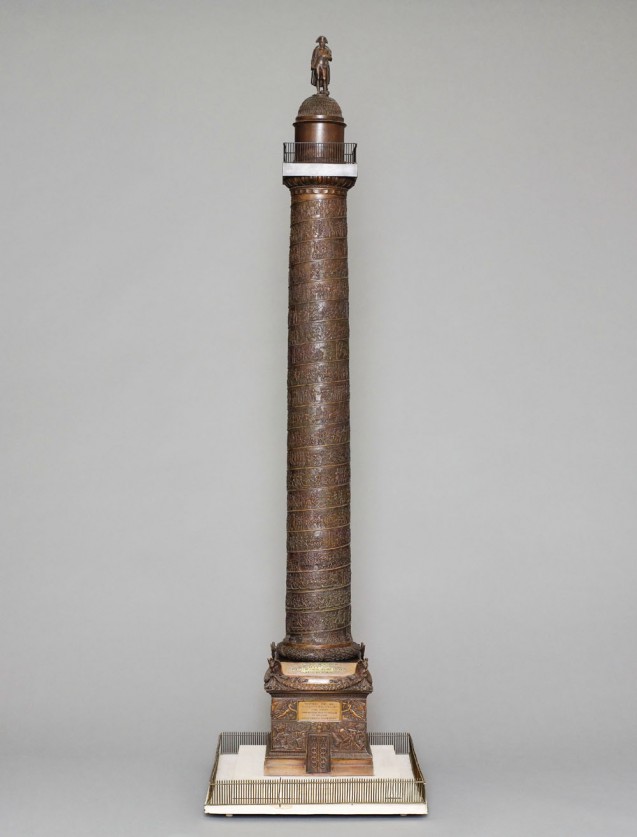This model was on show at the exhibition Napoléon et l’Europe at the Musée de l’Armée, Paris, from 27 March 2013 to 14 July 2013.
After the victory at Austerlitz, the director of the musée Napoleon, Vivant Denon, suggested to the Emperor that the project for a national column, begun in 1803 for the place Vendôme, be turned into a column honouring the soldiers of the Grande Armée. The column was successively named the Austerlitz column, then the Victory column, before being named the column of the Grande Armée.
The monument was constructed between 1806 and 1810 by Jacques Gondouin and Jean-Baptiste Lepère and was inspired by Trajan’s column, which the Emperor had thought of transferring from Rome to Paris. The artist used the reference to antiquity and its symbolic associations, whilst simultaneously rewriting them. Placed on a pedestal decorated with motifs of trophies taken from the enemy – cannons, uniforms, helmets, headdress, flags – the column was made up of a trunk of stone covered in 425 bronze plaques fixed by hooks. These were designed by Pierre-Nolasque Bergeret and were cast from Austrian canons, taken in 1805, and formed a spiral frieze of 280 metres which recounted the Campaign, from the camp of Boulogne to the Peace of Pressburg. An inscription indicated that the monument was erected to the glory of the Grande Armée by Napoleon the Great, started on 25 August 1806 and finished on 15 August 1810.
Originally, the column was supposed to be surmounted by a statue of Charlemagne. The monument was finally crowned by a statue of Napoleon as a Roman Emperor, sculpted by Antoine-Denis Chaudet. This statue was taken down in 1814 and very quickly disappeared. It was replaced in 1833 by an effigy of Napoleon in corporal’s dress, a work by Charles-Emile Seurre that today dominates the courtyard at the Invalides in Paris. In 1863, the statue of Seurre was taken down and replaced by a copy by Chaudet, made by Auguste Dumont.
The statue was removed at the time of the commune by Gustave Courbet, but was restored and rebuilt anew by the artist in 1873.
The inscription on the monument reads : NEAPOLIO IMP[ERATOR]
AVG[VSTVS]/ MONVMENTVM – BELLI GERMANICI/ ANNO MDCCCV/ TRIMESTRI
SPATIO DUCTV SVO PROFLIGATI/ EX AERE CAPTO/ GLORIAE EXERCITUS MAXIMI
DICAVIT. Sur la base : DONNÉ À l’HOTEL IMP[ÉRIA]L DES INVALIDES/ LE 2 XBRE
1857/ PAR S[ON] A[LTESSE] I[MPÉRIALE] LE PRINCE JÉRÔME NAPOLÉON/
GOUVERNEUR HONORAIRE
Paris, musée de l’Armée, inv. Dd 14
Pauline Leonet (tr. A.M), April 2013


